How to use the sanitary cable
What to do if the sink or bathroom is clogged and the water does not drain at all? Most often they try to cope with such a problem with the help of a plunger; however, this method is effective only in the case of a shallow blockage. The vacuum created by the manual plunger cannot extend its effect beyond the siphon. A plumber can solve a more serious problem. But, not everyone is aware of a fairly simple and effective tool that can even eliminate a deep and dense blockage - a plumbing cable. We will talk about what kind of tool and how to use the plumbing cable correctly.
About the benefits proven by time
The modern market is flooded with various means and devices designed to combat blockages, but over the years the sanitary cable has been and remains the most effective and popular means for eliminating this problem.
For the manufacture of the cable is most often used durable metal wire, twisted into a spiral. Some products have a plastic sheath that significantly reduces the likelihood of pipe damage during operation. Also, a distinctive feature of the cables is a different length (from 1 to 20 m or even 30 m) and thickness - from 6 to 13 mm. The diameter is a very important parameter that must be taken into account when choosing a tool, because the cable must move freely inside the pipe.
The main advantages are low price and compactness (the optimal storage method is a twisted form). In addition, the plumbing cable is very easy to use, with the help of a specialist is not required. It is possible to use a cable for any kind of communications and the most difficult blockages. Not only plumbing, but many practical people will definitely find such a tool.
Cable Types
Depending on the purpose, as well as the complexity of the blockage, there are several types of sewage cables.
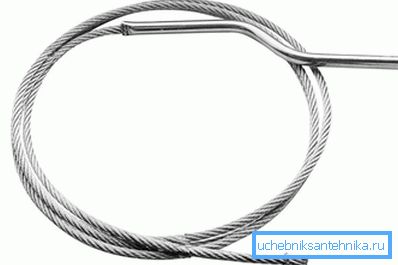
Cable. The diameter of such a tool is 6 mm, galvanized steel is used for manufacturing, and the optimal value does not exceed 5 meters (this is quite enough for the residential sewage system). The plant usually compresses the end of such a cable, but among plumbers it is practiced to give it a brush shape, as this helps to remove wool, hair and other causes of clogging. This design is characterized by excellent characteristics, namely high strength, durability, excellent elasticity and flexibility. Thanks to these qualities, the cable passes freely into the pipe, bend or sewer joint. But there is also a significant minus - the rope cable is too soft, which is why it is unlikely to be able to cope with a serious blockage.
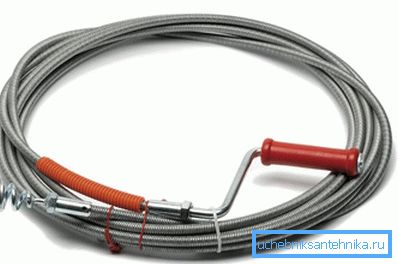
Flexible plumbing cable, as well as a flexible shaft or flexible hose. Such a device is much more convenient and efficient than a rope cable. The construction is as follows: a metal spiral is wound in 1 or several layers over the steel core. The permissible length of the product is 60 m, and the diameter is up to 28 mm.
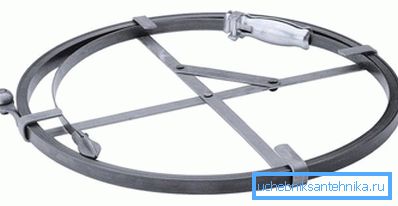
Metal ribbon It is also a type of sanitary cable. Comes complete with handpiece and grip. The length of the product reaches 30 m, and the width - up to 25 mm.

Spring. The length of this type of cable is 6 meters and its diameter is 9 mm. In accordance with the discharge, it can be called a household one, and at the base of its design is a hollow steel spring.
Tip! If the diameter of the plumbing cable is 13.5 mm and the length is 25 meters, then it is already a professional equipment capable of cleaning the riser or any other horizontal pipe.
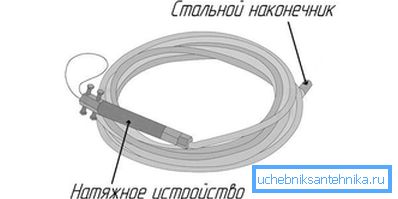
Tension. The design of the sanitary spring cable is represented by a flexible shaft entwined with spring-type wire. Tensioning it was called because during the turn of the handle it becomes rigid, like a rod. This tool is professional, as it can cope with a complicated blockage, which turned out to be beyond the power of an ordinary cable. A special drum is used to carry and store all-metal and steel cables in a vinyl sheath.

Electric cables, externally similar to the whole installation, they are used to clean a large-diameter sewer pipe. The electrical model looks like a cable equipped with a tip and a pistol grip wound on a special drum. Such a tool is able to clear any pipe, even from the most severe blockage.
The price of sanitary cable for cleaning sewer blockages is mainly influenced by the model and the manufacturer selected.
The procedure for removing blockages

Before you start cleaning the pipe, you need to familiarize yourself with the features of the standard drain system. The drain hole is connected to the siphon or water seal. Siphon is a pipe having a curved shape. Its main purpose is to block the unpleasant smell, always present in the sewage system. The siphon is connected to a branch pipe, which is subsequently connected to the main riser of the building. Such a complex structure requires maximum caution in its use, because due to abrupt and rash movements damage to the drain system can occur.
Work procedure as sanitary cable:
- First you need to unwind the cable and very carefully insert it into the drain hole. The cable must be advanced through the pipe until it hits the clog. But do not think that the first obstacle in the way is a blockage, most often it is a sharp turn of the pipe or joint. To check what kind of barrier you got in the way, you need to first pull out the cable a little, and then try rotating it, pushing it again. If the above movements do not give any result, then the goal is achieved - it is a blockage.
- Now you need to try to destroy the structure of the tube and push it further along the pipe using a nozzle with a pointed end. The tool must not only perform reciprocating movements, but also rotate around its axis. This is done with a special pen. If at the same time hot water flows into the drain pipe, it will have a softening effect on the cork and significantly speed up the cleaning process.
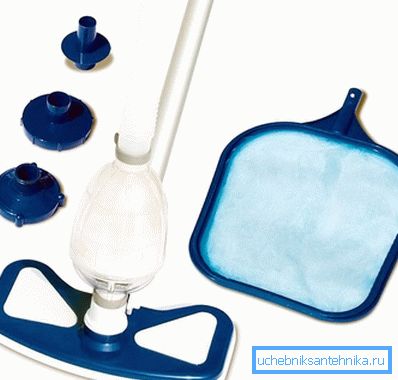
- As soon as the cable began to move freely in the pipe, you should carefully remove it and check how well the water is drained. To get rid of debris that has accumulated on the walls of pipes, it is recommended to rinse them for a few minutes with a stream of hot water.
How to clean the toilet with a cable

When clogging the toilet is also recommended to use plumbing cable. The principle of operation is extremely simple: the end of the cable must be inserted into the toilet, and then with the help of slow and accurate rotational movements push it inwards until it rests on anything. If the location of the blockage is a pipe, the cable will rest on it. After that, you need to try one of the following actions: either push the blockage forward, or hook and pull back with a special nozzle.
Video
This is how a blockage is eliminated with a cable: